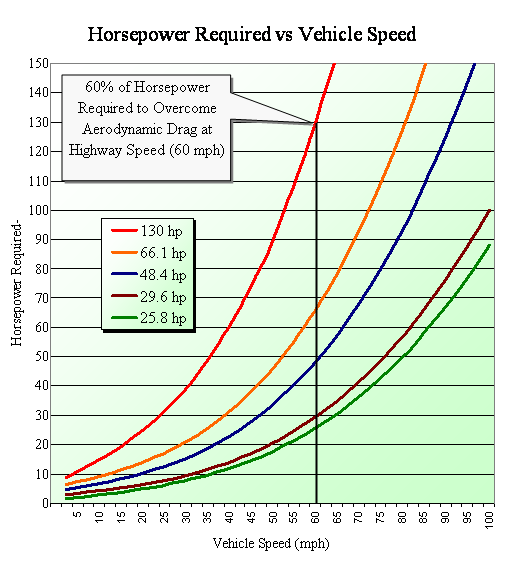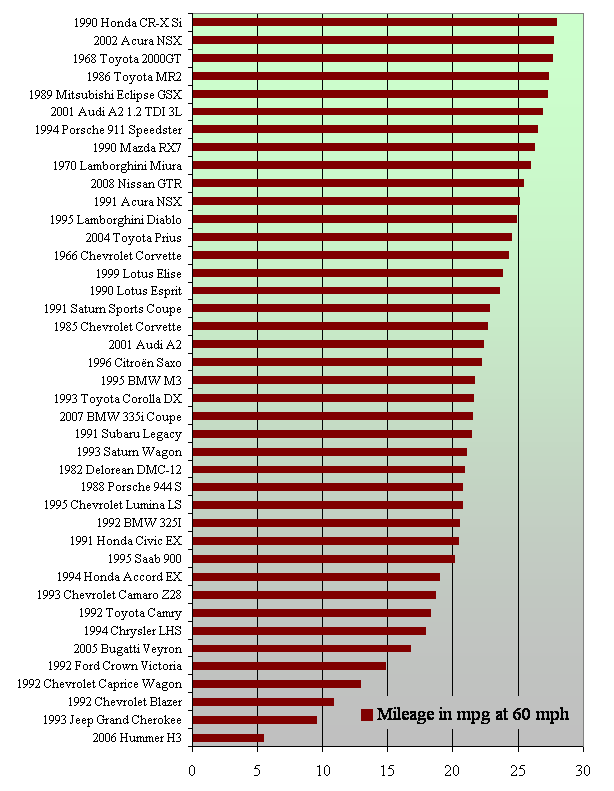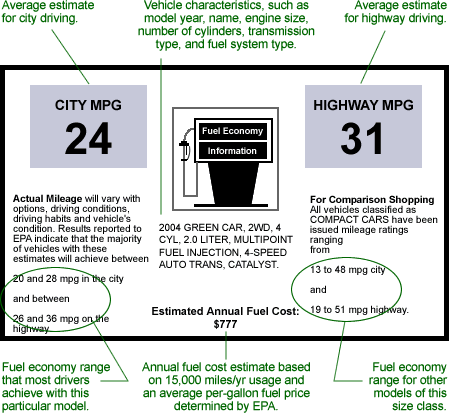|
Copyright ©2009 by Paul Niquette All rights reserved. |
|
Let us conduct our analysis in the power domain using simplified parameters for a vehicle traveling at v mph... Power to overcome aerodynamic drag = a v3where... a hp/mph3 is a coefficient relating wind resistance to powerSophisticated solvers will note that a lumps aerodynamic drag coefficient with characteristic frontal area commonly used to calculate wind force; that b combines rolling coefficient along with drive-train resistance, which are linear multipliers of speed; that c sums up internal power-plant loads as well as accessories which do not vary with vehicle speed. We have that... p[v] = a v3 + b v + c...where p[v] hp represents the requisite power to sustain vehicle motion at v mph. Substituting information parsed from statements in the puzzle, one is able to write four equations... {1} p[150]
=
1503 a
+ 150 b + c = 300
...and take note that there are four unknowns: a, b, c, and p[60]. It is not generally practical to make direct measurements of p[60] in a moving automobile. Solvers have been given only this: "At a 'highway speed' of, say, 60 mph, the Stingray's sleek design demanded a mere fraction of the engine's power, the rest being held in reserve for rapid acceleration." Solving these four equations simultaneously gives the following values: a = 0.0000823 hp/mph3  For calculating mileage, the puzzle invited solvers to assume an ideal Specific Horsepower of 2.0 hp/lb/hr. A gallon of gasoline weighs 6 lb, which means that for every gallon-per-hour consumed gph, the engine will deliver 12 hp. By simply dividing delivered hp by 12, we obtain the fuel flow rate in gph. Traveling at v mph, the vehicle consumes 1/12 gpm for each hp being demanded. By dividing gpm into mph we get what we want, mpg...
...and our solution to the puzzle...
Whereas the solution to the Look-at-Me Car puzzle has so far been conducted entirely in the power domain (hp), both aerodynamic drag and rolling resistance are customarily treated as forces (in lb or any other convenient unit described in Erg and Ugh). We might write... f[v] = a' v2 + b'where f[v] lb represents the requisite tractive force to move the vehicle at v mph. a' lb/mph2 is a parameter relating wind resistance (aerodynamic drag) to speedThe aerodynamic parameter a' is a function of shape (the extent to which the vehicle is streamlined) and size (in particular the vehicle's frontal area presented to the windstream). In Tin-Can Mystery, solvers confirmed that for objects of a given shape, various areas (surface area, cross-sectional area, wetted area) typically vary according as the two-thirds power of vehicle weight (w2/3) by virtue of the Cube-Square Law. The rolling resistance parameter b' is not a function of shape but varies directly with the vehicle weight (in particular the 'normal' force against the roadway). That force, of course, is supported by the wheels at their respective 'contact patches', which are four finite areas defined mostly by wheel diameter and tread-width. Thus, b' also varies according as the two-thirds power of vehicle weight (w2/3). Exclamation point optional. Using Ka and Kb for elementary constants of proportionality, the following relationships apply to a vehicle of a given shape, relevant to size, a' = Ka w2/3 and b' = Kb w2/3...indicating that for any value of a' determined by shape, there exists a corresponding value of b' relevant to size. We may then write... f[v] = a' v2 + b'...and setting a = a' and b = b', then for the 60-60 AME to apply, we make substitutions in equations {2} and {4}... p[60] = 603 a + 60 K a + 5...in which sophisticated solvers will find only constant relationships, flexing from p[60] and taking note of the fact that p[60] is itself a constant, inasmuch as v = 60 mph in the analysis. a = (40% p[60] - 5) / 60Using the formulation developed here, we are equipped to produce the 60-60 AMEs for various automobiles, including the 40 graphed below.  To find the maximum for 12 v / p[v] = 12 v / (a v3 + b v + c), set the first derivative to zero... d{12 v / p[v]}/dv = d{12 v / (a v3 + b v + c)}/dv = 0;...and solve for v and p[v]. Finally, as pointed out in To Brake or Not to Brake, mileage ratings for automobies...
...are empirically determined by an EPA
driver following a script on a dynamometer. That
these will be typically more generous than the
steady-speed 60-60 AMEs is explainable by the
low-speed segments of both the "Federal Urban Cycle"
and the "Federal Highway Cycle." |

